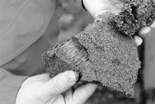


Contaminants leaking from hundreds of U.S. Department of Energy storage tanks, landfills, and trenches are polluting ground water and threatening the health of people and wildlife.
DOE's Office of Science and Technology is exploring the use of physical barriers as a way to quickly and effectively prevent the spread of radioactive and hazardous waste plumes. By blocking the advance of plumes, DOE hopes to control the contaminants until positive remediation is feasible. In 1996, DOE plans to demonstrate two types of physical barriers-cryogenic, or frozen, soil and viscous liquid.
Frozen soil barrier
Soil freezing is not a new science. Since the late 19th century, civil engineers have been using frozen soil barriers in many applications, including stabilizing loose soil during excavation and increasing the load bearing strength of soil during foundation construction. Frozen soil barriers have also been used to seal tunnels, mine shafts, and other underground structures against flooding.
Cryogenic soil barrier technology freezes the moisture in soil beneath the surface, forming an impermeable wall. The first step in installing the barrier is drilling holes for placement of refrigerant pipes. By using ResonantSonic drilling, which vibrates the drill into the ground rather than turning a conventional bit, less contaminated soil is excavated. This is helpful, because any contaminated soil brought to the surface must be remediated. The holes are placed at regular intervals surrounding the site, and pipes are installed in them.
After the holes are drilled, the site is leveled and the refrigeration units are brought in on tractor trailers. The refrigeration units pump coolant, which can be anything from salt water to many benign food products such as orange rinds, through the pipes. The pipes conduct the coolant's temperature to the surrounding soil, and moisture in the surrounding soil freezes, though the coolant itself does not contact the soil directly. The amount of frozen soil around each pipe spreads until the sections of ice connect, forming the barrier.
The barrier takes from eight to fifteen weeks to form, depending on soil type and the moisture content of the soil. Using more pipes and placing them closer together decreases the amount of time needed to form the barrier. Once the barrier is fully formed, permanent refrigeration units are brought in and placed in outbuildings to maintain the wall.
The maintenance of a frozen soil barrier costs less and uses less energy than forming it. Automated equipment maintains a constant temperature, and the site requires only periodic checks by personnel. If a breach in the barrier is found during normal operation, adding moisture to the area will usually repair it.
 In 1994, Scientific Ecology Group, Inc., in
conjunction with RKK Limited, performed an OST-sponsored frozen
soil barrier demonstration at SEG's Gallaher Road facility in Oak
Ridge, Tennessee. SEG excavated a 56-foot long, V-shaped trench
and placed in it a 750-gallon tank filled with simulated waste.
The simulated waste was allowed to migrate into surrounding soil.
A frozen soil barrier was installed, along with 141 sensors to
monitor the barrier and track the simulated waste. Upon
completion of the project, testing showed that a barrier 10- to
12-feet thick had been formed surrounding the site.
In 1994, Scientific Ecology Group, Inc., in
conjunction with RKK Limited, performed an OST-sponsored frozen
soil barrier demonstration at SEG's Gallaher Road facility in Oak
Ridge, Tennessee. SEG excavated a 56-foot long, V-shaped trench
and placed in it a 750-gallon tank filled with simulated waste.
The simulated waste was allowed to migrate into surrounding soil.
A frozen soil barrier was installed, along with 141 sensors to
monitor the barrier and track the simulated waste. Upon
completion of the project, testing showed that a barrier 10- to
12-feet thick had been formed surrounding the site.
In March, DOE's Oak Ridge Operations Office released a request for proposals for the construction of a frozen soil barrier at the Homogeneous Reactor Experiment pond. Between 1957 and 1961, the pond, which is at DOE's Oak Ridge National Laboratory, received and treated low-level liquid waste from the Homogeneous Reactor Experiment-2 evaporator. The pond measures 79 feet by 76 feet, with an average depth of nearly 13 feet. The sediment in the pond is contaminated mostly with cesium and strontium, as well as small amounts of plutonium, uranium, americium, and curium. Polychlorinated biphenyls and heavy metals have also been detected. After use of the pond stopped, ORNL filled it with soil and shale and capped it with asphalt.
By using a frozen soil barrier at ORNL, DOE hopes to reduce the contamination reaching nearby White Oak Creek. The alternative to containing the plume would be remediating the site, which would cost several million dollars. When remediation is complete, the frozen soil barrier will be removed by simply allowing it to thaw.
 Viscous liquid barriers are composed of
inert liquids that increase their viscosity after being injected
into the soil, forming an impermeable wall. They are similar to
frozen soil barriers in that they surround and contain a plume.
Unlike frozen soil barriers, viscous liquid barriers are a
gel-like mass rather than a wall of frozen subsurface moisture.
Viscous liquid barriers are composed of
inert liquids that increase their viscosity after being injected
into the soil, forming an impermeable wall. They are similar to
frozen soil barriers in that they surround and contain a plume.
Unlike frozen soil barriers, viscous liquid barriers are a
gel-like mass rather than a wall of frozen subsurface moisture.
DOE is investigating three general types of barrier fluids, all of which are chemically and biologically inert. The first type of fluid is a member of the polybutene, or PB, family. The viscosity of PB is temperature sensitive. It is practically solid at surrounding ground water temperatures. PB will not dissolve in water and is impermeable to water and gases. Installation of PB barriers requires heating the vadose zone, which is the layer of soil just above the ground water level. The liquid is injected at the same temperature as the soil, then the barrier forms as the soil cools.
The second fluid is polysiloxane. PSX is a silicon-based polymer that is unaffected by the chemistry of the aquifer or of the plume. The viscosity increase in PSX is the result of mixing with other substances and temperature control.
The third barrier fluid is colloidal silica. CS is a silicon-based grout that is installed using a cooling process, or gelation. The pH, temperature, and the chemistry of the fluid and soil affect the time required for CS to gel.
A full-scale application of a viscous liquid barrier is being performed at the DOE Savannah River Site. In September 1996, a CS barrier will be installed at the H-Area Retention Basin at SRS. The basin is an unlined pond that was used from the mid-1950s to the early 1970s for emergency and temporary storage of potentially contaminated cooling water from chemical separations. The pond is roughly 120 feet by 200 feet, with an average depth of six feet. There are over 15,000 cubic yards of contaminated soil in and around the basin.
A small field test to determine permeability was performed on the surrounding soil in June of 1996. CS injection is scheduled to begin on September 23. It is estimated that 2,350 tons of CS will be required to fully isolate the basin. When the basin is completely isolated, continuous monitoring of the barrier's integrity and quality of the water within the enclosed area will be possible. DOE will develop a remediation plan while installation of the barrier is being performed. Injection of CS should be completed by 1997.
![]()